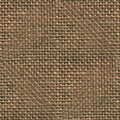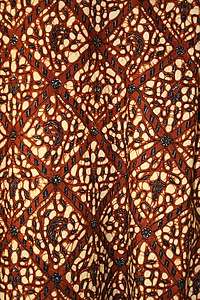Donegal tweed
Donegal Tweed is a woven tweed manufactured in County Donegal, Ireland. Originally all handwoven, it is now mostly machine woven and has been since the introduction of mechanised looms in the 1950s/1960s. Donegal has for centuries been producing tweed from local materials in the making of caps, suits and vests. Towards the end of the eighteenth century, The Royal Linen Manufacturers of Ulster distributed approximately six thousand flax spinning wheels and sixty looms for weaving to various Donegal homesteads. These machines helped establish the homespun tweed industry in nineteenth-century Donegal.[1] Although Donegal tweed has been manufactured for centuries it took on its modern form in the 1880s, largely due to the pioneering work of English philanthropist Alice Rowland Hart.[2]
While the weavers in County Donegal produce a number of different tweed fabrics, including herringbone and check patterns, the area is best known for a plain-weave cloth of differently-coloured warp and weft, with small pieces of yarn in various colours woven in at irregular intervals to produce a heathered effect. Such fabric is often labelled as "donegal" (with a lowercase "d") regardless of its provenance.
Along with Harris Tweed manufactured in the Scottish Highlands, Donegal is the most famous tweed in the world. While tweed in Ireland is by no means exclusive to Donegal, Vawn Corrigan confirms Donegal as the heartland of Irish Tweed [3]. It was used in several of the fashion designer Sybil Connolly's pieces.
Magee of Donegal Town
The firm of Magee dates back to 1866. It was established by John Magee (1849–1901) who established a retail shop in the Diamond, in Donegal Town. He also bought tweed from Ardara and Carrick from part-time weavers who also worked as farmers and fishermen.[4]
In 1887, John Magee's cousin Robert Temple (1866–1958) came to work in the shop as an apprentice. On the death of John Magee in 1901, Temple took over the business. He continued using the outworkers to make tweed but in order to improve quality he established a system of sending out patterns and materials to these workers. Later he established a small factory in Donegal Town where some of the outworkers worked full-time under his supervision. Robert Temple expanded the business significantly until his death in 1958.[5]
Robert's son Howard Temple (1913–2010) began working with his father in 1931. One of the most significant figures in the history of Donegal tweed, Howard Temple carried Magee to new heights. The number of weavers (both in-house and outworkers) were greatly increased and he began the process of making Donegal tweed an international brand. To this end he collaborated very closely with the Irish fashion designers Sybil Connolly and Irene Gilbert. In 1966 he also established a large factory in Donegal Town manufacturing ready-to-wear men's clothes which at its peak employed approximately 300 people.[6]
The current proprietors of Magee are Howard Temple's son Lynn and Lynn's children Charlotte and Patrick. Magee continues to be the largest and most famous producers of Donegal tweed.[7] Magee clothing is worn by the 9th President of Ireland Michael D Higgins.
Triona Design
A fifth-generation hand weaver, Denis Mulhern, had a strong desire to ensure that the tradition of handweaving was maintained and preserved.
In 1992, Triona became the Bord Fáilte Ireland approved Triona Donegal Tweed Centre and the Mulhern family began to welcome visitors from across the world to showcase first-hand the skills involved in hand weaving.
The entire Mulhern family have dedicated their lives to protecting and nurturing the skill, craft and heritage of the traditional Donegal Tweed.[8]
Smaller Donegal tweed companies
Based in Kilcar, Co Donegal, Studio Donegal was founded in 1979 to preserve the tradition of hand weaving. Originally established by the now defunct Connemara Fabrics under the leadership of Kevin Donaghy. Kevin and his wife Wendy bought the operation from Connemara Fabrics, and it continues today under the management of their son, Tristan Donaghy. Remaining true to its original objective, all the tweed produced in Studio Donegal is genuinely hand woven.[9]
Eddie Doherty continues to hand weave in his shop/weaving room in Ardara Co Donegal.[10]
The Weaver
"The Donegal Weaver was, and indeed still is, a singular type of man. He normally has a long Celtic face with good long-fingered hands, a highly sensitive touch, and an inherent feeling for colour, amazingly dexterous feet and an inbuilt sense of rhythm. This freedom of movement is vigorously displayed in the skillful dancing of jigs and reels at the weaver's parties held each year in Donegal Town."[11]
(Studio Donegal has a young female weaver, so the skill is not solely the domain of men)
References
- Hoad, Judith (1987). This Is Donegal Tweed, Shoestring Publications, Inver.
- "British and Irish Home Arts and Industries, 1880-1914: Marketing Craft, making Fashion | Irish Academic Press". irishacademicpress.ie. Retrieved 2018-05-19.
- Corrigan, Vawn (2020). Irish Tweed: History, Tradition, Fashion. O'Brien Press. ISBN 9781788490214.
- "Our History – Heritage Timeline | Magee". www.magee1866.com. Retrieved 2018-05-19.
- "Heritage woven into modern life - Independent.ie". Independent.ie. Retrieved 2018-05-19.
- "Force behind expansion of Magee clothing". The Irish Times. Retrieved 2018-05-19.
- "Heritage woven into modern life - Independent.ie". Independent.ie. Retrieved 2018-05-19.
- Official website
- "History | Studio Donegal | Woollen Mill | Handweaving | Buy Handwoven Garments". www.studiodonegal.ie. Retrieved 2018-05-19.
- "Home". Eddie Doherty Hand woven Tweed. Retrieved 2018-10-27.
- Reade, Linda (1973). Aranwear and Tweed. 64 Harcourt St Dublin: Zircon Publishing Ltd. p. 52. ISBN 0-7179-2013-5.CS1 maint: location (link)


.svg.png)